Good team communication keeps things running smoothly whether in the office or remotely. With Pumble’s clean interface and real-time chat capabilities, teams can connect instantly. When all communication and collaboration happens in one place, teams can stay transparent and productive no matter when or where they’re working from.
Pumble is a business messaging app that makes on-site, hybrid and remote team communication much easier. Using Pumble will save you from getting stuck in endless text or email threads. Plus, Pumble is accessible on multiple platforms including macOS, Linux, and Windows, ensuring broad compatibility for users on different operating systems.
In this guide, we’ll introduce you to team communication in Pumble and highlight its importance for successful teamwork.
Then, we’ll provide you with an overview of key Pumble features that facilitate effective team communication:
- Channels,
- Threads,
- Video conferencing,
- Voice and video messages,
- Scheduled messages,
- Search,
- Notifications, and
- Guests.
We’ll focus on the main benefits of Pumble for team communication, and offer some advice on how to get started with effective team communication.

Step 1: Create your digital headquarters
Like with every app, you’ll have to take a few steps to set up everything for a successful start of your Pumble journey:
- Make an account,
- Invite your team members, and
- Set up the channels you need.
Make a Pumble account
The first step in your Pumble journey is to create a workspace. As Pumble is part of the CAKE.com Suite, the first thing you need to do is create a CAKE.com account. By creating it, you’ll have access to other CAKE.com’s apps – Clockify and Plaky.
Once you finish setting up your CAKE.com account, you can start with creating your Pumble workspace. To make your journey easier, Pumble has an app for Windows, Mac and Linux, as well as mobile apps for both iOS and Android.
After you’ve downloaded the apps you want, enter your email address as the first step or just continue with Google. If you’re going with your email, the next thing is to check your email where you’ll receive a verification code (as it connects your email account with the workspace) and enter it in the modal.

Now, you’ll input the name of the Company/Team and click Create workspace.
And, voila! You have your Pumble workspace and your first channels: #general and #random.
You can continue by setting up your channels, profile, and main information!
Invite your team members
Inviting your team members to your Pumble workspace is quick and straightforward. On the desktop or web app, click your workspace name in the top-left corner and select Invite people. On the mobile app, tap the icon menu and choose “+Invite people”.
Now, you can choose how to invite your team. There are two ways: by email and by link.
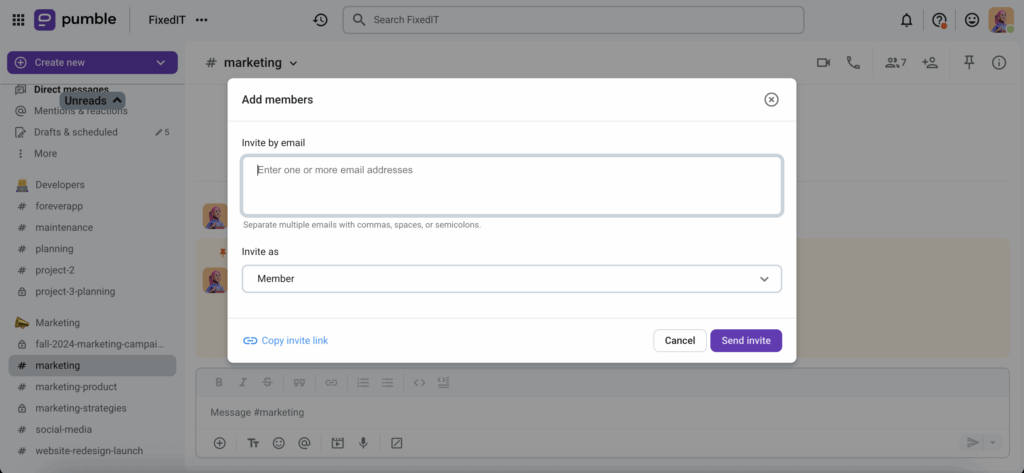
If you choose email, you need to enter the email addresses of the people you want to add and then click on “Send invite” to send invitations.
The other option is to invite people via link. Copy the invite link and share it with your team through other chat, email or any other channel.
🎓 Pumble Pro Tip
Use the invite link when you want to add a larger group of people quickly.
Set up the channels you need
Now that your workspace has been created and you have your two default channels, it’s time to create more channels. You can create channels suited to your needs and separate them into categories dedicated to projects, teams, or any other category you find important for your business.
Pumble has two types of channels.
Public channels are open to everyone in the organization, while private channels are restricted to selected, invited members.
This structure allows teams to balance transparency and confidentiality, ensuring that the right people have access to the right information.
One of the primary advantages of channels is that they enable team members to find and respond to essential information quickly.
Channels help you centralize all discussions about a specific project or task, making it simple to inform team members about the latest developments. Channels also facilitate easier access to specific information, allowing team members to find what they need fast without going through cluttered email chains.
Step 2: Organize conversations with channels
One of the biggest advantages of Pumble is the ability to organize team communication in channels.
Unlike direct messages, which are best suited for one-on-one or small group conversations, Pumble channels provide a dedicated space for topic-based discussions.
Using channels in Pumble helps teams stay focused, collaborate, and keep important information accessible to anyone who needs it.
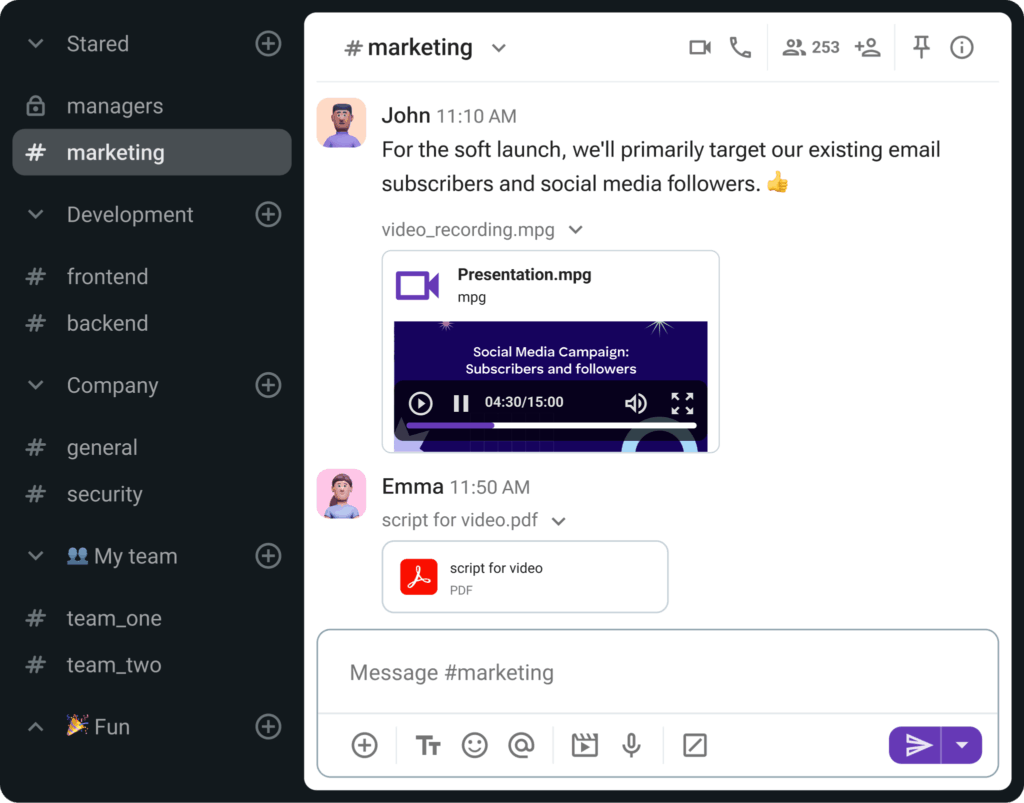
Some of the general advantages of using channels:
- Transparent and centralized communication accessible to current and future team members,
- Permanent, searchable message and file history,
- Channel browsing lets everyone discover public channels to join.
Why channels matter for team communication
When all conversations happen in private channels or direct messages, it quickly becomes difficult to find information.
Channels solve this problem by grouping messages, files, and discussions around specific topics, projects, or teams.
This structure helps:
- Reduce noise by separating casual discussions from project-related updates,
- Make onboarding new team members easier, since they can browse channel history,
- Encourage collaboration across departments without losing focus.
Public channels in Pumble can be accessed via All channels in the sidebar. All team members can join public channels and get access to all information posted in these.
Public channels thus promote transparency by ensuring more efficient knowledge sharing within an organization. They are used for team communication in a certain project component, such as marketing. For example, all discussions concerning the project’s marketing progress take place in the #marketing channel.
Private channels, on the other hand, are used for sensitive and confidential conversations. Only those who are invited can view the channel or find its contents in search. People must be added to a private channel by someone who’s already a member of the channel. Messages or files posted in a private channel can only be searched by members of that channel.
🎓 Pumble Pro Tip
When you create a channel, you can decide if it will be public or private. It can be turned from public to private and the other way around only by Owner or Admin.
Best practices for channel naming
Clear channel names are essential for keeping your workspace intuitive. A good naming system ensures that anyone can quickly find the right channel and understand its purpose.
Here are a few best practices:
- Use prefixes to categorize channels. For example: team- for departments channels (team-marketing), fun- for social or non-work discussions (fun-music)
- Keep names short and descriptive so that they’re easy to scan — limit to 80 characters.
- Avoid duplicates to prevent confusion.
- Establish workspace-naming rules so everyone can follow the same protocol.
Having consistent and intuitive names will make navigating Pumble channels much easier for everyone.
Managing channels
Creating channels is just the beginning. To truly benefit from Pumble channels, you also need to manage them effectively. Channel management ensures that conversations remain organized, accessible, and relevant over time.
In Pumble, any non-guest member can create public and private channels.
When creating a new channel, you’ll be asked to give it a name, and, optionally, a description. While the description might seem like a small detail, it helps new members immediately understand the purpose of the channel.
Once a channel is created, its members can begin exchanging messages, sharing files, joining calls, and collaborating in one place.
Over time, you may find that a channel’s purpose shifts. For example, what started as a temporary project space might evolve into a long-term department channel. In these cases, Pumble lets you edit the channel name and description to better reflect the current role. Only the channel creator, or in some cases the Owner, has the ability to rename or adjust default channels.
Finally, channel management also involves setting boundaries on participation. In channels where clarity is essential, such as the #general channel, Admins can limit posting permissions so that only certain people can share updates. This prevents clutter and ensures that key information doesn’t get buried under casual conversations.
Step 3: Bring focus to discussions with threads
Threads in Pumble can be your best friend if you’re using them properly. The simple threaded message can bring a lot of order in your channels.
Also, you can reply inside the thread, react to a message, or tag your team member.
But let’s start from the main benefit of threads in Pumble.
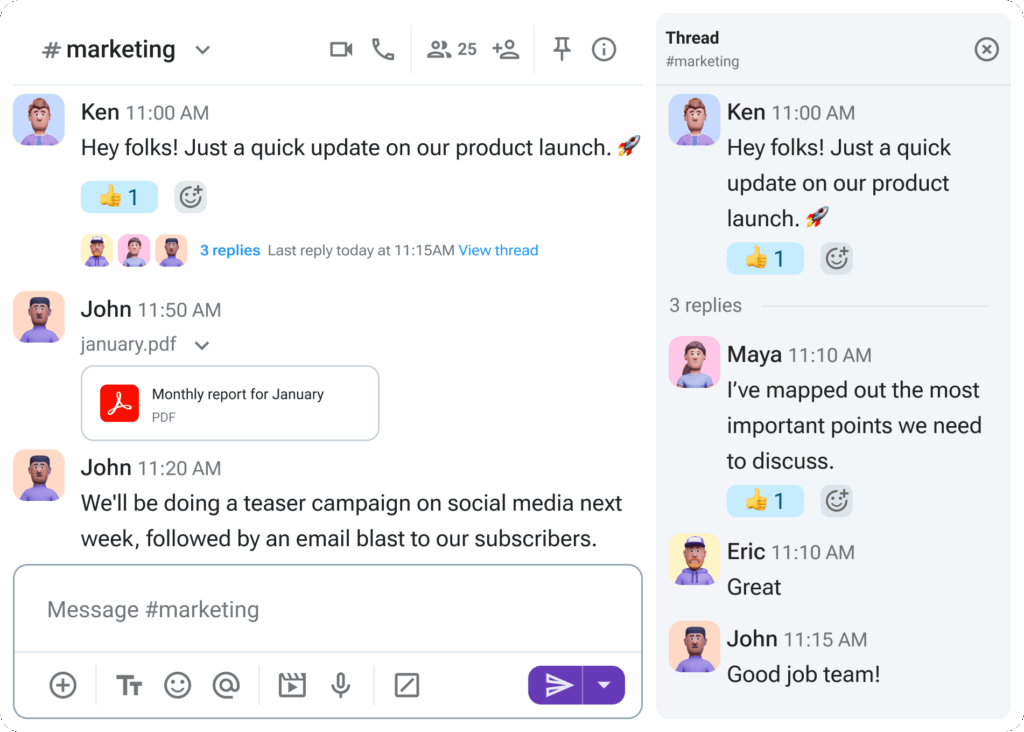
Instead of posting numerous replies directly in the channel or DM, you can start a thread by replying to the specific message.
Threads can be used to:
- Keep the announcement channel clear and uncluttered,
- Reduce the need for direct messages by keeping the flow inside a thread, and
- Keep the important team members involved into discussion by using @mention in threads.
How to use Pumble threads?
Using Pumble threads is pretty simple. Whether you’re on a desktop or mobile device, using threads is the same.
On your desktop and web browsers, you need to hover over the message and choose the message box named “Reply in thread”. And just start typing.
On your mobile phone, long press on the message you wish to reply to and tap the “Reply in thread” icon, enter the message and send it.
To see all of your threads, go to your sidebar, and at the top of it, you’ll see the “Threads” option. All threads with any unread replies will appear at the top of the list. From your Threads view, you have a couple of options:
- Reply to any thread,
- Click on the channel name in the header of the thread to see the original message,
- Click on three dots icon to unfollow a thread, and
- Choose Turn off notifications about replies to complete the action.
When to use threads and when to respond in a channel?
When there is a choice of where to send a message, to start a thread or to just reply in a channel, you need to take a couple of things into consideration. First, check whether there is an active discussion in a channel. Then, consider how many people are in the channel and if your response will be relevant to all of them.
When you have a team of people and your channels are really busy, the only logical answer is to use threads, to avoid cluttering the channel and to keep discussion about specific topics in one place. No cluttering the channel, no messy messages equals one happy team.
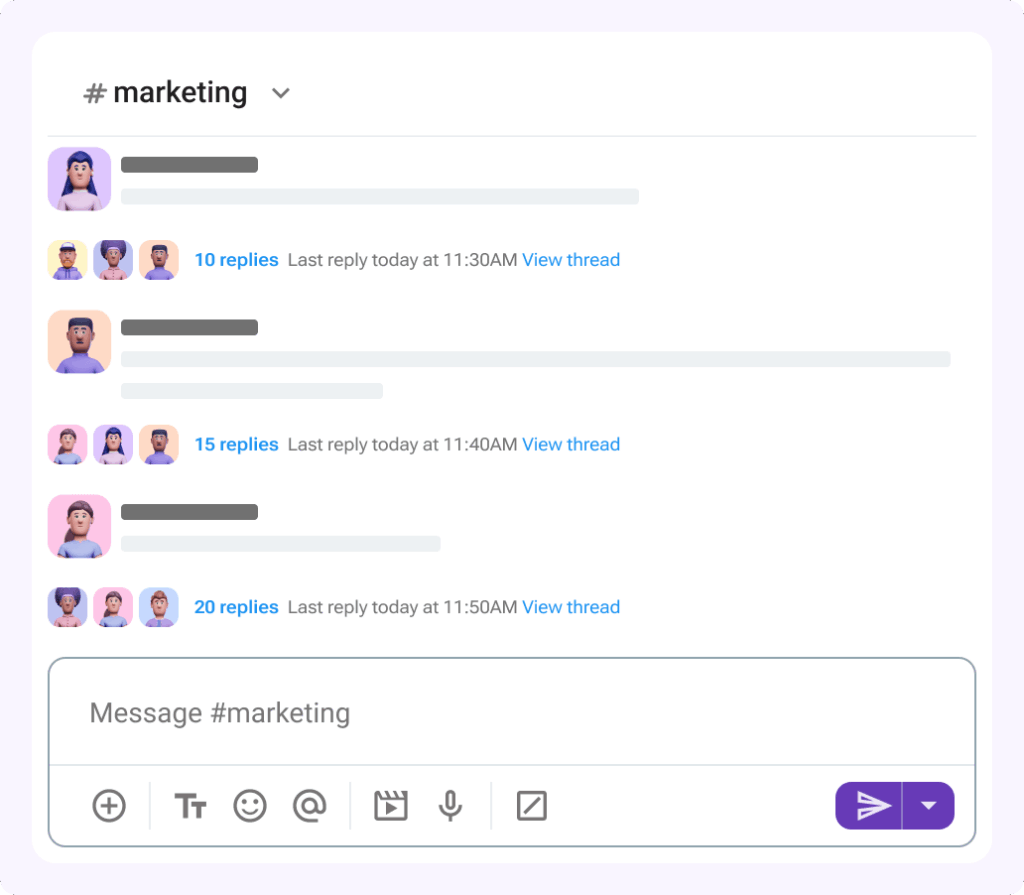
Threads also can help reduce the use of direct messages for questions and answers. Instead, questions can be posted in threads in public channels where details remain transparent and accessible.
One important use of threads in Pumble inside a channel is to send a threaded message directly to a channel. It can be very useful when some important decisions are made in a thread. Check the box “Also send to #channel” and your message will be sent to a channel and notify everyone about the decision you made.
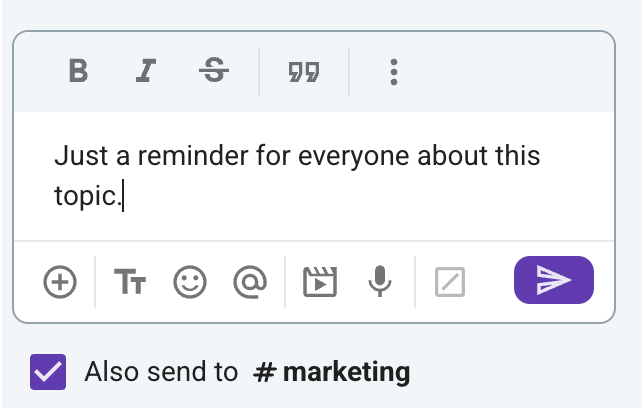
How to follow a Pumble thread?
When you reply to a thread, you automatically start following all replies in that thread and get notifications for it. But what if you want to follow a thread but not reply to it? Of course you can do it.
Go to the thread, and press the three dots and choose “Notify me about new replies”. This way, you’ll get notifications every time someone responds to this thread.
Unfollow threads
Unfollowing a thread in Pumble is very easy and simple. Hover over the original message and click on the three dots. Select the first option — “Turn off notification about replies”.
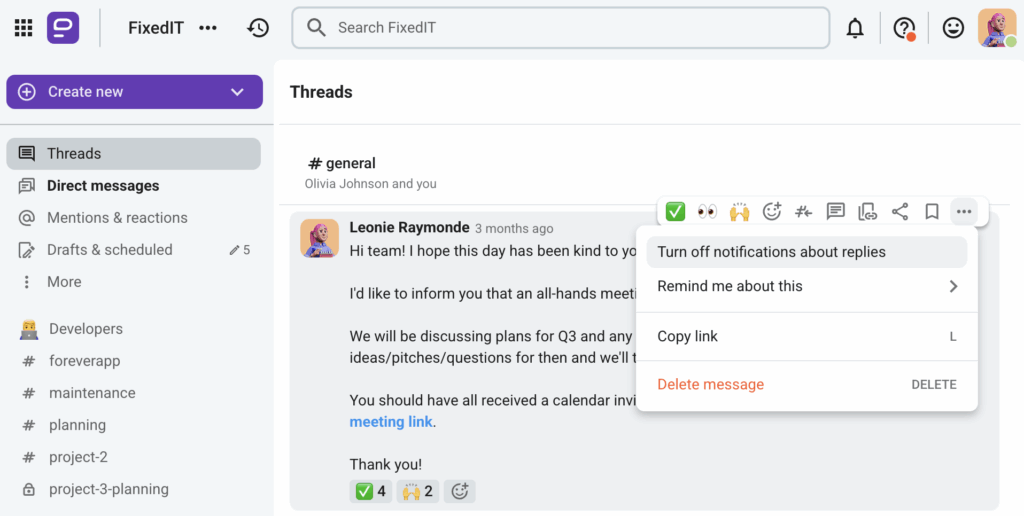
Suddenly, your notifications are a little less crowded, and you can focus on the most relevant threads.
Mark threads as unread
What to do if important answers are always sent in threads, but you have a lot of work, and you can only focus on it later? Simple. You can mark the threads you need to come back to later as unread.
To mark a thread as unread use the three dots menu and select “Mark unread”. If you notice this happens a lot, there’s always one more option — Remind.
Remind me about thread replies
Select a time when you want to be reminded about the thread reply.
As for a regular message you can choose between:
- 20 minutes,
- 1 hour,
- 3 hours,
- Tomorrow (9 AM),
- Next week (Monday at 9 AM), and
- Custom — choose when you want to be notified.
To select a time when you want to be reminded, hover over the thread reply, and choose “Remind me about this”.
When you use this option correctly, you basically create yourself a to-do list. Every time your selected time comes, you’ll get a message from Pumblebot reminding you about your scheduled task.
Step 4: Master real-time and asynchronous communication
What is asynchronous communication?
To put it simply, asynchronous communication is the one that is not happening in real time. This means team members can share everything in a communication tool, but the answer is not needed and not expected immediately.
Examples of asynchronous communication are:
- Texting,
- Instant messages,
- Email, or
- Recorded videos.
On the other hand, real-time communication is happening in real time.
For effective communication at work, businesses need to practice both asynchronous and real-time communication. A recent study found that 70% of respondents find it valuable to have decision-making meetings in real-time.
Video conferencing
In Pumble you can have two types of meetings — video conferencing and voice meetings. With Pumble video conferencing, you can make calls and connect with anyone from your team. You can connect over video, using one-to-one or group video calling. To have a one-on-one meeting, you can send a meeting link to a colleague, or just call by clicking the camera icon in your chat.
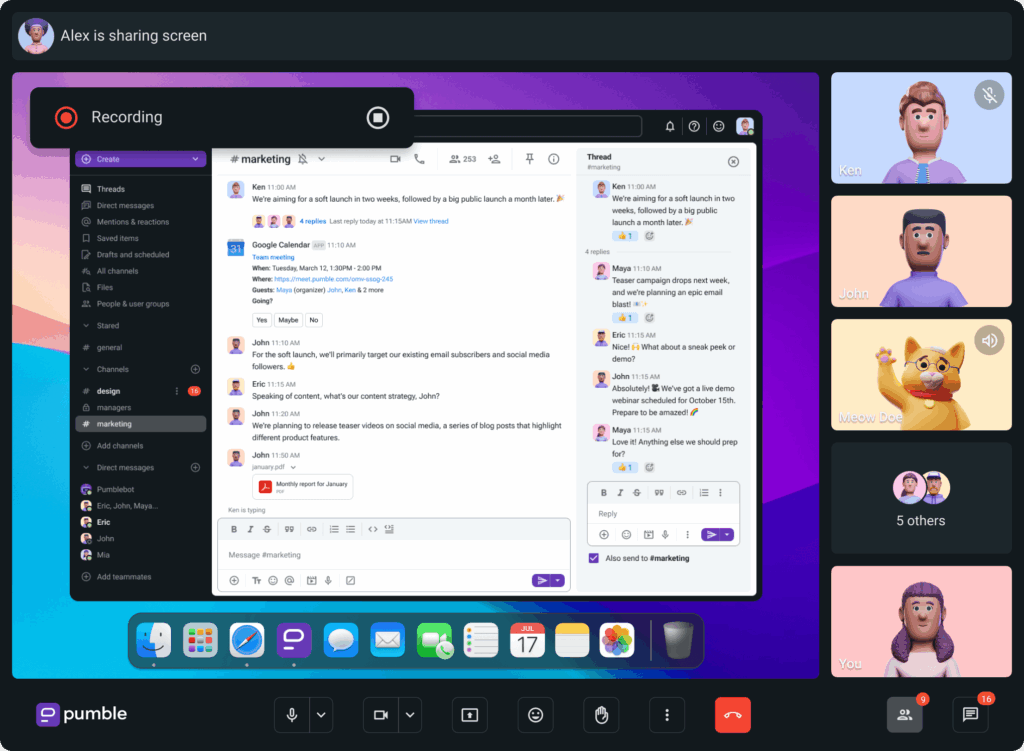
For group meetings, it’s much better to use a meeting link instead. Sending a meeting link helps you invite only the relevant people. In most cases, you won’t need everyone from the channel on a call.
Another way to join a meeting is through Google Calendar. When someone schedules a meeting in Pumble, the Google Calendar integration can notify you that your meeting is starting in a minute. This way, you’ll never miss any meetings. Just click the link, and you’ll be in a meeting.
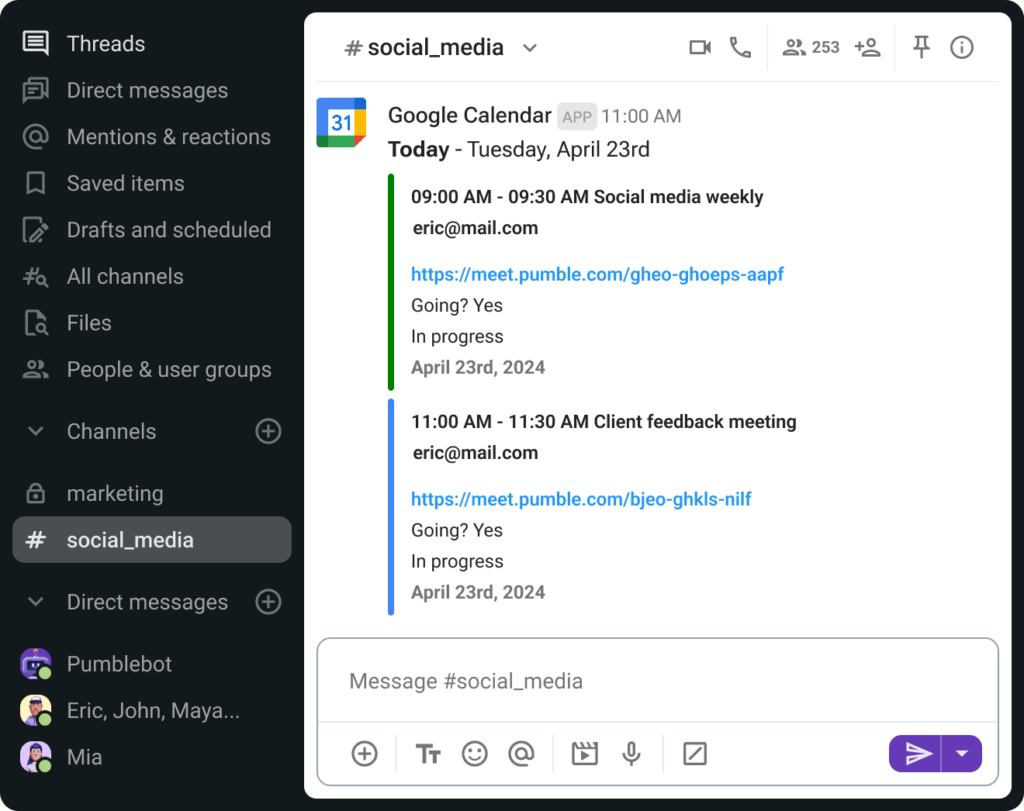
With Pumble, you can easily connect with your team members, clients, or partners through high-quality video conferencing, no matter where you are.
It’s perfect for remote teams, because it allows everyone to stay in sync and fosters a sense of real presence — just like being in the same room would.
Video conferencing calls can be launched from any channel or direct conversation in Pumble.
You can start a video call, or join one.
Voice calls
When it comes to voice calling, you’ll join them with your camera turned off, only your microphone will be on. Instead of seeing each other, you’ll only hear voices and see your profile photos on Pumble.
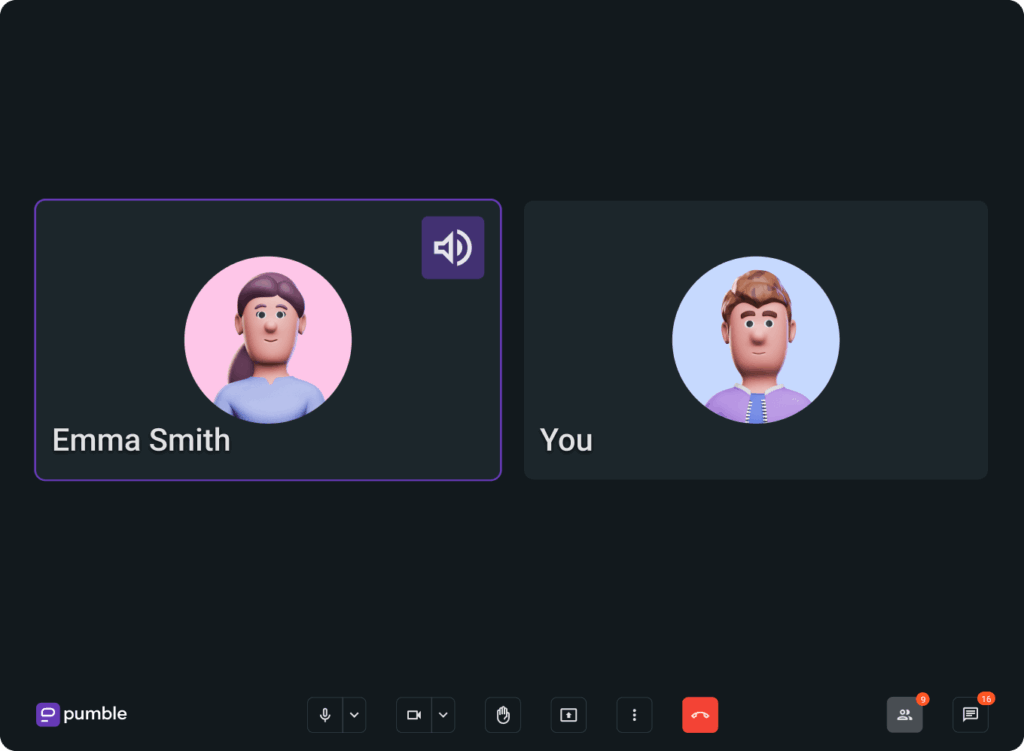
To call anyone in your Pumble workspace, all you have to do is open the conversation with that person and click on the phone icon to start a voice call. Same as for video calling, it’s much better to send a meeting link in voice calling if you want to make a group call, so everyone relevant can join.
Hold team meetings over Pumble
Screen sharing
Pumble lets all meeting participants share their entire screen, only one window, or specific tabs.
In most cases, participants will share a screen when they want to:
- Present: share slides, documents, or any other visual aids to support their presentation,
- Host demos: show how to use a particular software,
- Collaborate in real time: work together on a document or project, or
- Troubleshoot a problem: help someone solve a technical issue by viewing their screen.
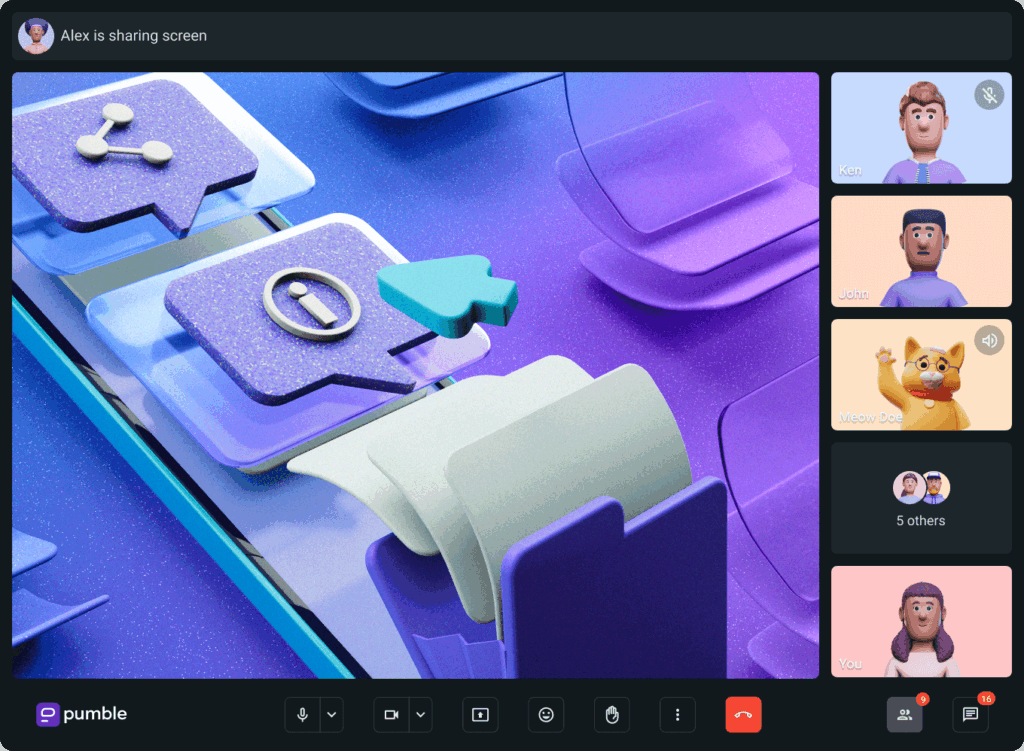
By using screen sharing in Pumble, you can improve the way you and your teammates work together remotely. With the ability to share your screen and collaborate from anywhere, your team can be more productive and efficient in completing tasks.
How to use scheduled messages?
When you’re working remotely, there’s a big chance of working with teammates from all around the globe. You probably won’t have the same working time, nor the same habits. Or some of your closest colleagues may decide to work after standard working hours but they don’t want to bother you in your free time.
In all of these scenarios, the ideal solution are scheduled messages. Messages will be sent at the time you select without intruding on anyone’s free time.
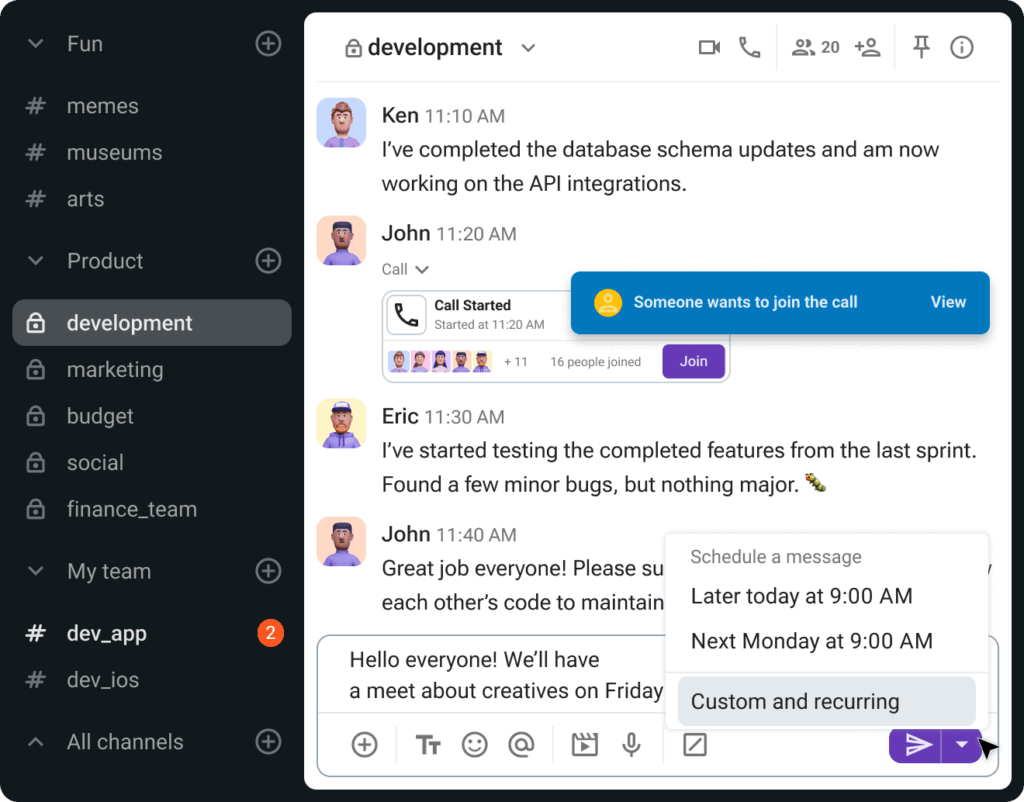
Scheduling messages in Pumble is simple:
- Type the message you want to share via a DM or in a channel,
- Click on the arrow beside the sending button, and
- Select the time you want the message to be sent.
You can also set a custom time and date for a message to be sent (for example, if you’re sending a message to a colleague who is on a holiday and you know their return date).
Another option is to set a recurring message. Recurring messages let you schedule messages that will automatically be sent at regular intervals to specific users.
With this feature, you don’t have to send repeated messages to team members, as you can set the Recurring messages once, and Pumble will do the rest.
When you set the time and date, the next step you need to take is choose the recurrence of your message:
- Daily,
- Weekly,
- Biweekly,
- Monthly,
- Every quarter,
- Annually, or
- Every weekday.
After you choose when you want the message to be sent, you can choose when it ends. There are also a few options:
- After occurrences, or
- Specific date.
Once you set everything, go to Schedule a message and you’re good to go.
After you’ve scheduled the message, an info line will appear in the DM/Channel stating that a message will be sent.
Click the “See all scheduled messages” option to see the list and content of all scheduled messages and drafts.
If you want to make changes, simply hover over your scheduled message and click on the pencil icon on the right, which represents editing. This allows you to modify the content in the message field before it’s sent.
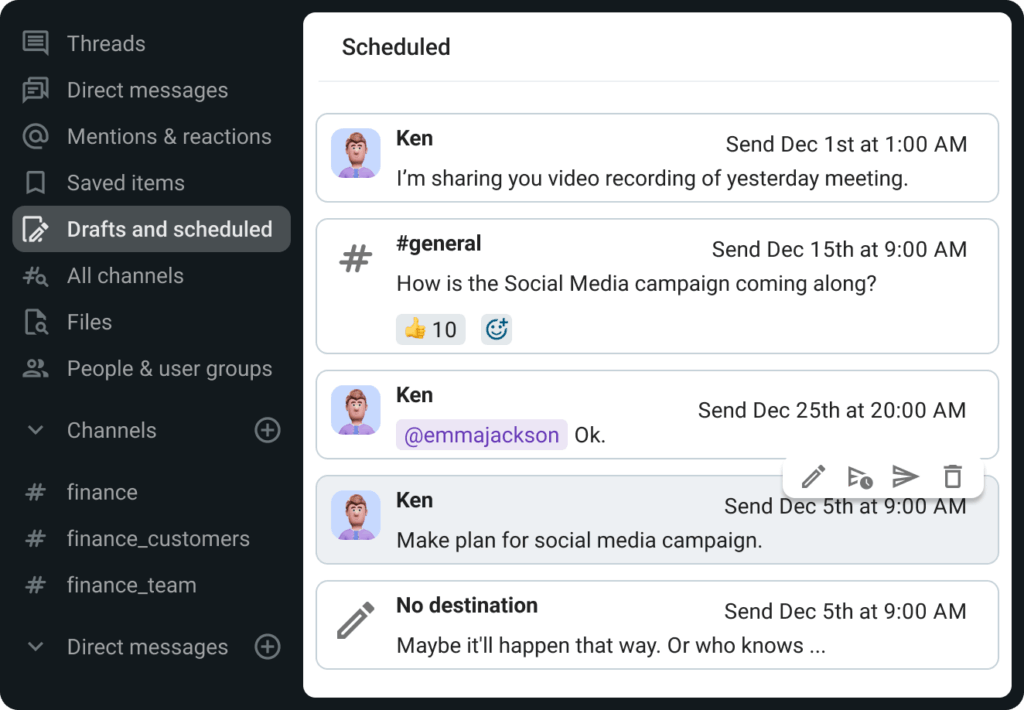
You can also change the date and time of your scheduled messages if you need to. Again hover over your scheduled message and click the icon next to the edit icon.
The list of all scheduled messages is also available in the Drafts & Scheduled sidebar section.
Using voice messages
Imagine you’re in a hurry, a big hurry, and you need to send a quick message to your coworkers. But, instead of typing it, you can send a voice message to a channel where everybody can access it.
When the message is too long or complex, voice messages can be a more efficient way of communicating. Moreover, speaking is faster than typing, especially when you’re on the go.
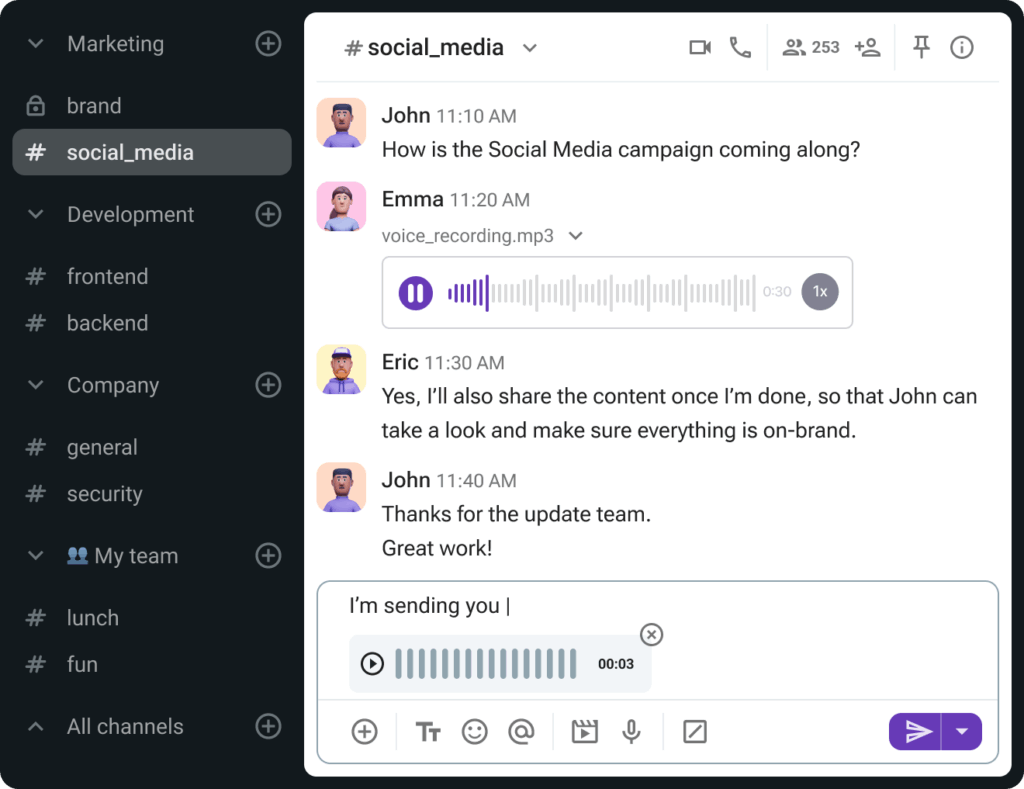
By using voice messages, you can adjust your tone of voice, make a message more personal and more memorable at the same time. We all know how important it is to adjust a message so that they come across the way you intended. And for some people, voice messages are their most common form of communication on a daily basis.
Most team communication and collaboration tools, such as Pumble, make it simple to record and listen to voice messages.
This is how you do it in Pumble:
- Open the channel or DM where you want to send the voice message.
- Press the microphone icon.
- Start recording your message.
- When you’re finished recording, press the checkmark.
- Add a text message to your voice message if you want.
- Send the message.
Using video messages
Even more than voice messages, video messages let you explain complex ideas, pitch proposals, and clarify goals in a way that other messaging formats can’t. Whether you’re presenting a new product or updating colleagues on the latest campaign results, video ensures your message stands out.
Also, written messages often lack clarity, requiring a lot of follow-ups. Video messaging, on the other hand, delivers clear and concise communication, saving time for everyone involved.
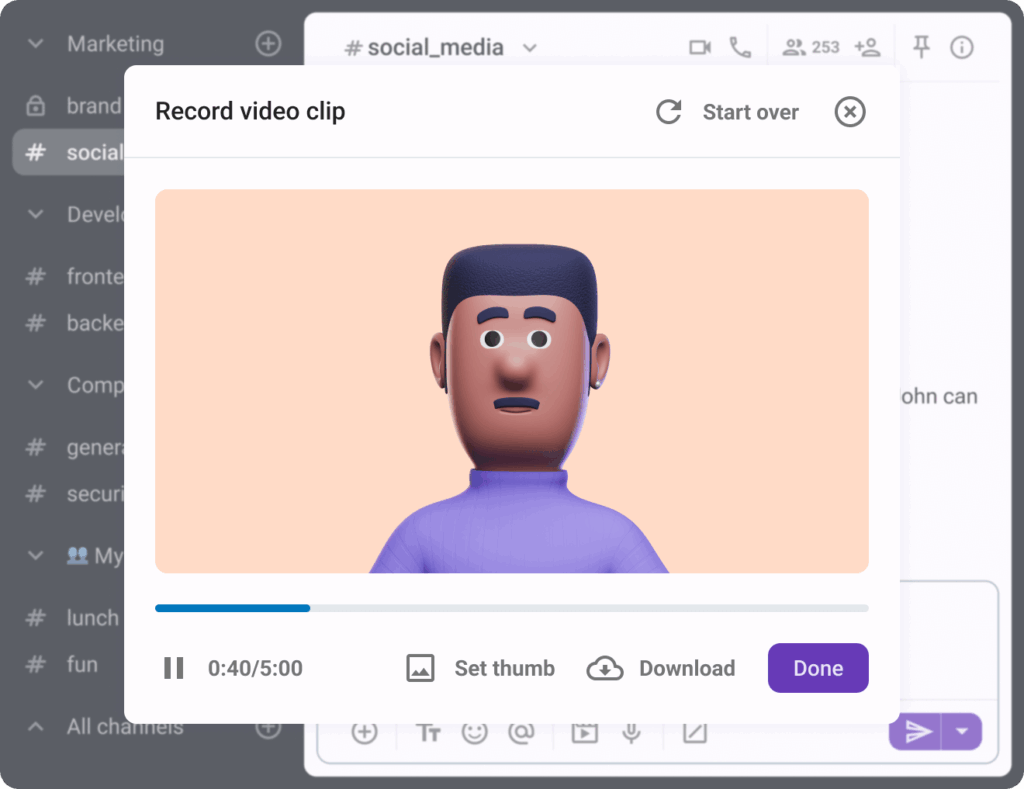
When you send partners a personalized video message, they don’t have to dig through messages. They see your face, hear your voice, and understand the context in seconds.
And for all of that, the time-zone doesn’t matter. You’ll send a video message, they will watch it at their own time. It’s effective, efficient and productive at the same time.
Here are the steps you need to take to record and playback video messages in Pumble:
- Open the Pumble app on your device and navigate to the channel or direct message where you want to send the video message.
- Click on the “Camera” icon next to the voice message box.
- Click the red “Record” button to start recording your video message.
- Record your message by pressing the button and speaking into your device’s microphone. You can record for up to 5 minutes.
- Once you’re done recording, select the “Stop” button. You’ll have the option to preview your video message before sending it.
- Click on the “Done” button to share your video message within the selected channel or DM.
- You can enter text in the text box to send it together with the video.
Record and send video and voice messages with Pumble
Step 5: Build your team’s searchable knowledge base
In Pumble you have unlimited access to your messages and files by default without any limits.
This means you can search all your conversations at any time. So, unlike many team communication tools that have different limits on past conversations unless you upgrade, Pumble gives you unlimited messages history on the FREE plan.
This can transform Pumble into a permanent, searchable knowledge base for your company.
And, search in Pumble means:
- No more lost messages or files.
- No need to ask “Where did we talk about this?”
- Instant access to decisions, links, and shared documents.
Unlimited messages history = Unlimited search
Most collaboration platforms restrict message history on free plans, meaning you can only search the most recent messages. If a project details or document was shared months ago, it’s gone unless you upgrade.
With Pumble, there’s no such barrier. The free plan includes unlimited message history, so your team can search across the entire timeline of your company’s conversations. From day one to year five, nothing is lost.
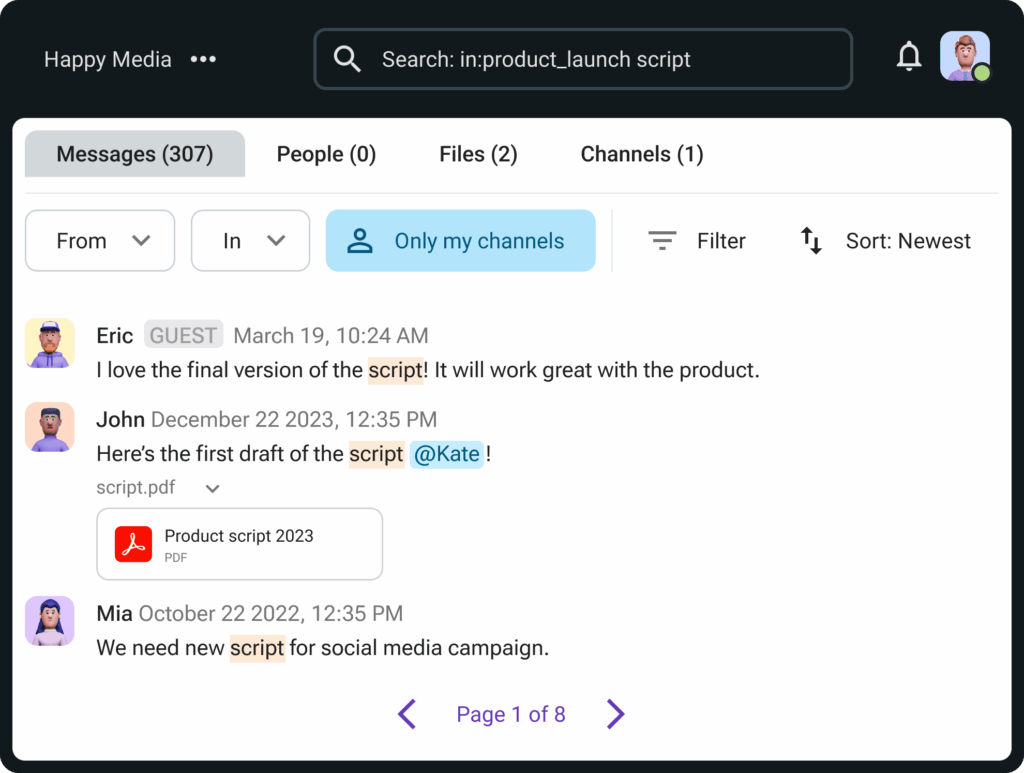
This makes search in Pumble not just a feature, but the backbone of your company’s knowledge management strategy.
When paired with unlimited message history, search in Pumble delivers long-term value across the company:
- A living knowledge base — every decision, brainstorm, or file ever shared is permanently available.
- Faster onboarding — by searching old conversations, new employees can catch up on past decisions, projects, and company culture.
- Reduced re-sharing — instead of asking colleagues to re-share details, team members can find the answers they need.
- Team transparency — teams working on different projects can still access relevant knowledge.
- Long-term compliance — for industries where documentation and compliance matter, having a searchable archive of every conversation is essential.
How Search in Pumble works?
Pumble’s search is designed to be fast, intuitive, and precise so you can find what you need in seconds.
Here’s how it works.
Search by keyword
Type in a specific word or phrase to instantly find every message or file where it appears. It’s perfect for tracking down project names, client details, or specific tasks.
Search across channels and direct messages
No matter where a conversation happened — in a public or private channel or a direct message — Pumble will find it. You just enter the channel name if you know it or a colleague’s name if you’re searching for a direct message, and that’s it.
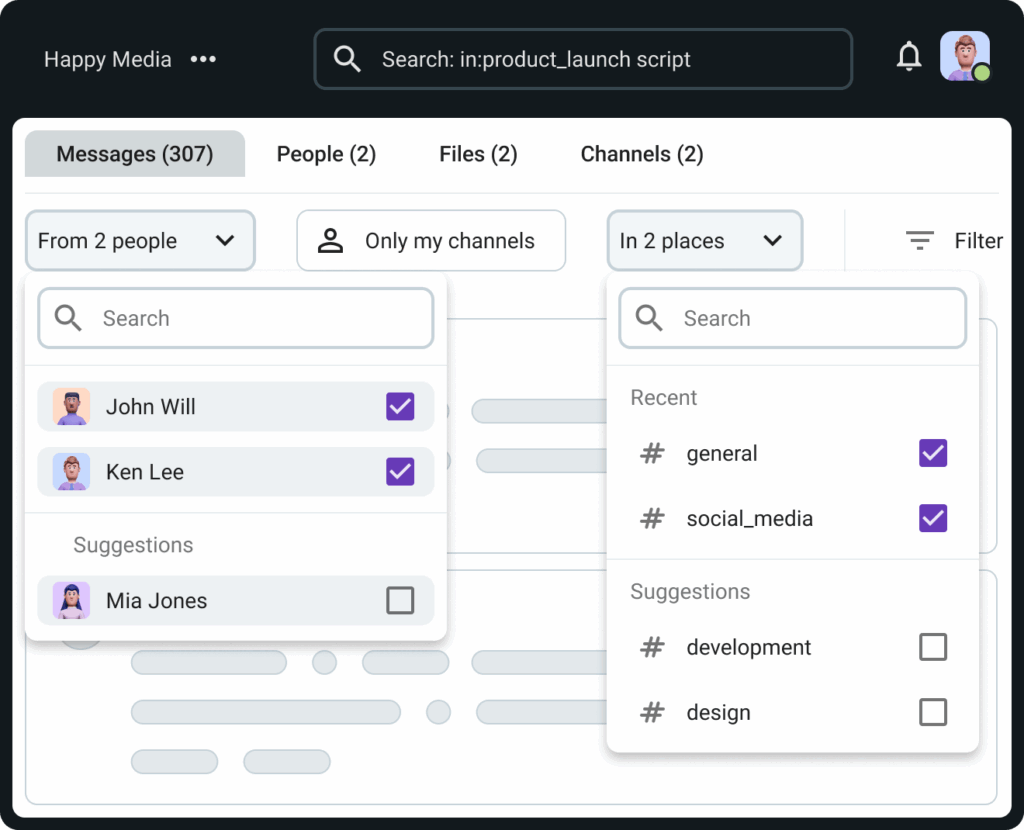
Search for files and links
Pumble’s search also works for file names and links, so you can quickly locate that one presentation or a document shared months ago.
Best practices for making the most of search in Pumble
To maximize the benefits of search in Pumble, consider next:
- Use clear, consistent channel names (e.g. #proj-marketing, #client-macros, etc.) to make search results more meaningful,
- Encourage descriptive file names when sharing documents (e.g. q2-budget-report.pdf, final–version-2.pdf, etc.),
- Leverage message pinning and threads for high-value decisions, and then use search to access them later.
Over time, Pumble can become a lot more than just a messaging app. It can become your company’s memory and a living knowledge base.
Step 6: Manage your focus and reduce noise
In today’s digital workplace, communication never stops. Messages, updates, and mentions can escalate quickly, making it difficult to separate what is urgent and what’s just noise. That’s why Pumble notifications are designed to keep you informed while protecting your focus.
With smart features like mentions, the do-not-disturb mode, channel muting, and the option to pause notifications, notification settings in Pumble give you full control — you decide when, where, and how you want to be notified.
Why Pumble notifications matter
Without the right notification settings, collaboration tools can become productivity killers. Constant pings distract from deep work, and important updates get buried in the flood of messages.
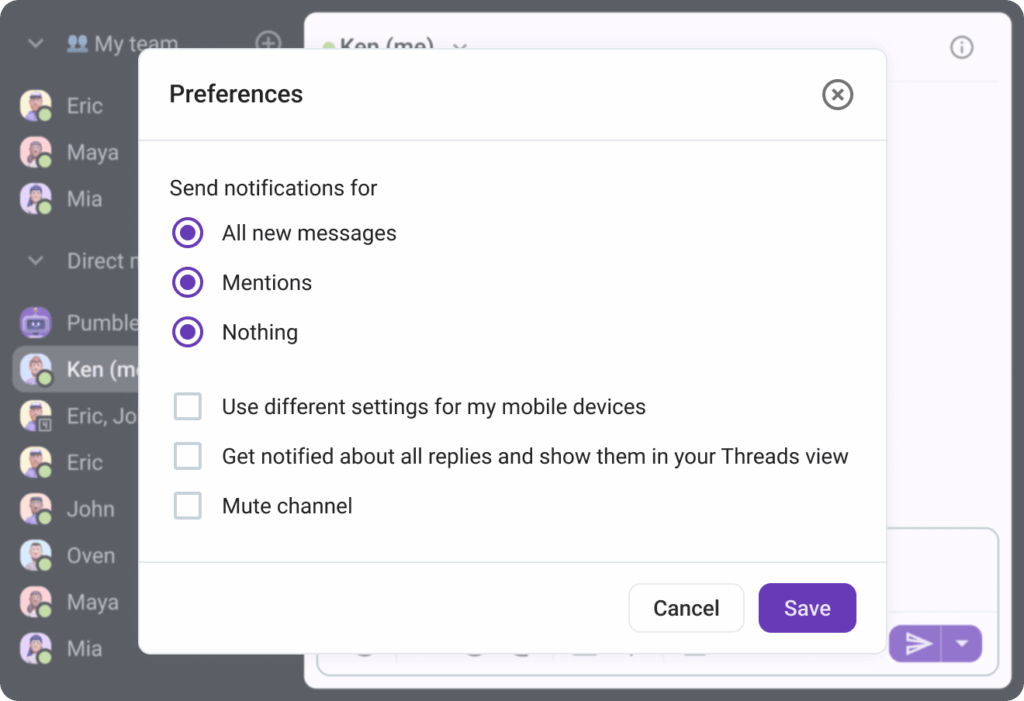
That’s why Pumble notifications are built to balance two key needs:
- Stay informed about what really matters, and
- Protect focus time by minimizing unnecessary distractions.
With unlimited messages already included on Pumble’s FREE plan, notifications work hand-in-hand with search to ensure you never miss critical information whether you see it in real time or look it up later.
To get the most out of notifications in Pumble, try these:
- Customize notifications by channel — keep urgent channels active and mute the rest,
- Use Do-not-disturb mode during deep focus hours,
- Encourage mentions only when input is necessary, and
- Pause notifications during meetings and presentations.
How Pumble notifications work
Flexible notifications in Pumble adapt to your role, team size, and working style.
Standard notifications
By default, Pumble notifies you when you have new messages in channels or direct messages. This ensures you’re always aware of active conversations.
Mentions in Pumble
One of the most powerful aspects of Pumble notifications is the way mentions are handled. In a busy workspace with multiple channels, thousands of messages can flow through daily. But not every message needs your attention. That’s where mentions make all the difference.
When a teammate types @yourname, you’re instantly notified. Even if the channel is muted or your general notifications are limited, Pumble ensures that mentions override those settings so you don’t miss something important.
Types of mentions in Pumble are:
- Channel-wide mentions — when you want to announce something important for everyone, use @channel or @here.
- Direct mention — notifies one specific person (e.g., @Emma) and it’s perfect when someone needs your input, review, or decision.
- Group mentions —when teams use user groups (e.g., @design-team) and want to be looped in without spamming anyone.
Based on types of mentions, best practices for them are:
- Use direct mentions when you need a clear response,
- Avoid overusing channel-wide mentions to prevent notifications fatigue,
- Establish team guidelines around when and how to mention people, and
- Encourage teammates to use mentions as a way of assigning responsibilities and not just for random updates.
Mentions essentially turns notification in Pumble into a prioritization system — instead of reacting to everything, you’re alerted only when it really matters.
Do Not Disturb mode
While staying informed is important, constant notifications can damage focus and increase stress. That’s why Pumble includes the Do Not Disturb mode, giving you the ability to silence notifications during specific times.
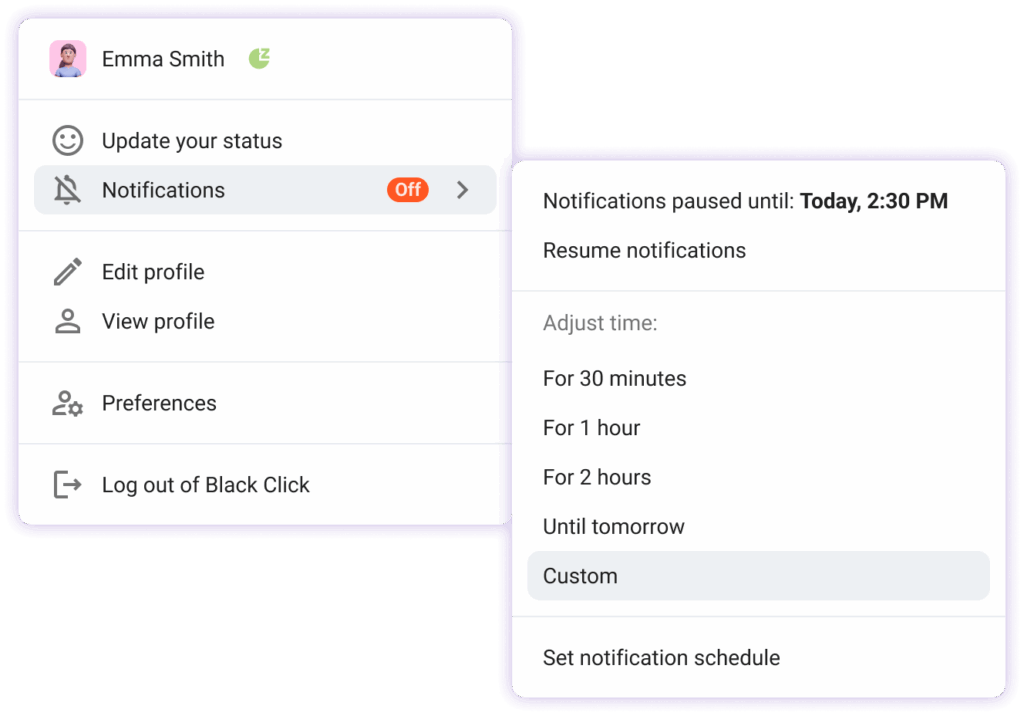
With the Do Not Disturb mode, you won’t receive pop-ups, sound, or third-party app notifications, but messages will still arrive in your workspace, waiting for you when you’re ready. This helps you take control of your workday, protect personal time, and maintain healthier boundaries.
Our recommendation is to use the Do Not Disturb mode:
- During deep work sessions — you can block notification for a few hours when you need total focus,
- In meetings and presentations — prevent distractions during important calls,
- After work hours — be sure you’re not pinged late at night or during weekends,
- During vacations and personal days — let colleagues send updates without disturbing your time off.
Benefits of the Do Not Disturb mode are:
- Reduces stress and helps avoid burnout,
- Encourages work-life balance in remote and hybrid teams,
- Prevent distractions while still keeping conversations stored and searchable,
- Allows colleagues to respect boundaries while keeping communication flowing.
🎓 Pumble Pro Tip
Even when the Do Not Disturb is enabled, you can review all missed mentions when you’re back online. Since mentions highlight what’s most relevant to you, you don’t waste time catching up on unimportant chatter.
Mute channels
Not every channel is equally important. For example, a casual #pets chat doesn’t require the same urgency as a #proj-deadline channel. With the mute channel settings, you can silence notifications from specific channels while still being able to check them on your own schedule.
Pause notifications
If you need uninterrupted focus, Pumble lets you pause notifications temporarily. Whether you’re writing, coding, or presenting, you won’t be disturbed until you choose to resume alerts.
Benefits of notifications in Pumble
When used intentionally, Pumble notifications help teams strike the right balance between responsiveness and productivity.
Here’s why they matter:
- Prioritize what matters most — mentions and custom notifications ensure you see the messages that are meant for you, without being bombarded by every minor update.
- Protect your focus time — with pause notifications and Do Not Disturb mode, you can block distractions when working on deep tasks.
- Reduce stress and burnout — by controlling your notifications, you can reduce anxiety caused by constant pings.
- Smarter communication — when teams know that mentions trigger notifications, they naturally become more mindful of how they tag colleagues.
- Flexible for different work styles — Pumble notifications will adapt your workflow, no matter what your position in a company is.
Step 7: Collaborate beyond your core team
Modern teams rarely work in isolation. From freelancers and consultants to clients and vendors, external collaboration is essential for getting projects done.
But inviting outside partners into your team’s communication space can feel risky. Either you give them too much access or restrict them so much that collaboration becomes frustrating.
That’s where guests in Pumble make a difference. This feature lets you invite external partners to collaborate in a secure, flexible way, without disrupting your team’s internal workflow.
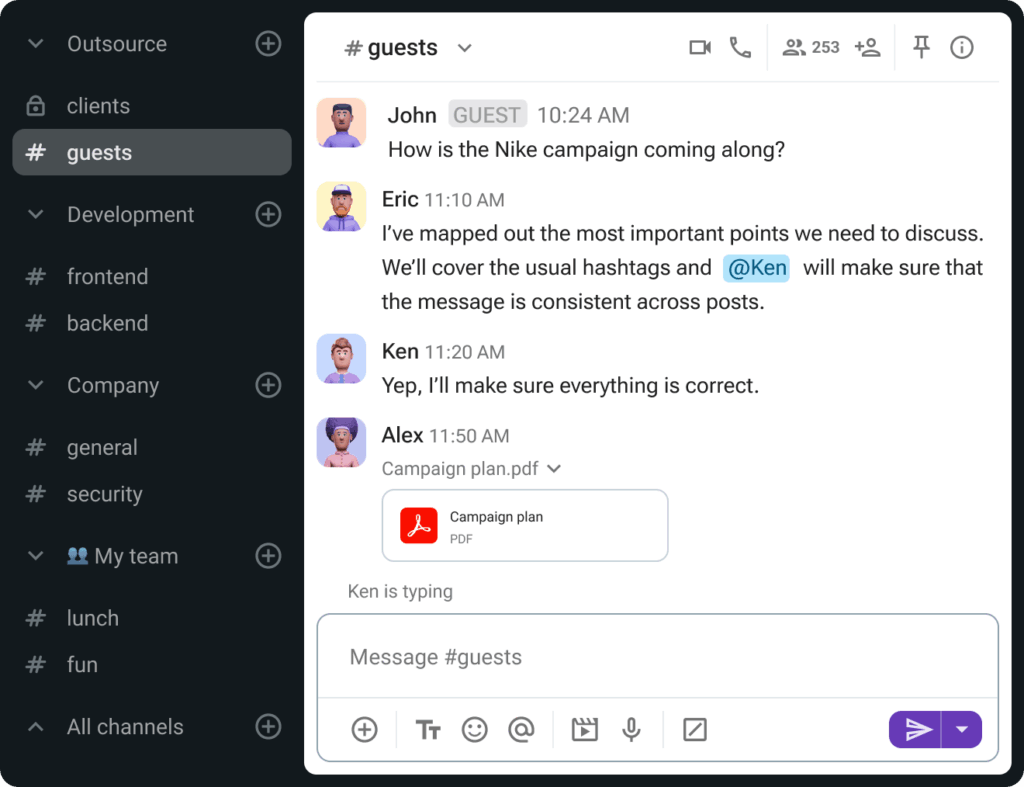
Whether you’re working with a designer, contractor, or long term client, guest access helps you manage transparency and speed.
As we know, the rise of remote work and distributed teams has blurred the lines between internal and external.
A marketing agency might work closely with a client’s in-house team. A software company might bring in freelance developers or consultants. A non-profit might partner with donors or sponsors.
Without the right setup, these collaborations can run between emails, files, and ad-hoc messaging apps. That creates silos, slows projects down, and increases the risk of miscommunication.
By inviting guests in Pumble, you centralize all collaboration, both external and internal, in one place. Everyone communicates within the same workspace, but with role-based access that keeps things safe and organized.
How guests in Pumble work
Guests in Pumble are special user roles designed specifically for people outside of your core company. Unlike full members, guests have limited access, ensuring they can only see what’s relevant to their work.
Pumble offers two types of guest access:
- Single-channel guests — these guests can access only one channel, where all relevant communication is kept in one place. This is perfect for short-term collaborations with freelancers or partners who only need to follow one specific project.
- Multi-channel guests — these guests can be added to several channels at once, allowing them to follow conversations across different projects or teams without becoming full workspace members. This role is perfect for long-term or multi-project collaborators.
🎓 Pumble Pro Tip
Guests can only initiate a DM with a member who’s in the same channel(s). Members, however, can initiate a DM with any guest, even if they’re not in the same channel.
Work smarter with shareable meeting links
With Pumble’s shareable meeting links, you can instantly set up a video call and send the link directly to an external partner — no downloads, no complicated setup.
Guests, clients, or freelancers can simply click the link and join the meeting directly in their browser or Pumble app.
This makes it easy to:
- Brainstorm ideas with clients without switching to another platform,
- Review deliverables with freelancers face to face and provide feedback instantly,
- Hold progress updates with external partners in a secure environment, and
- Replace third-party meeting tools and keep all collaboration in one place.
Because the link is shareable, even people who aren’t permanent members of your workspace can join your call. That means smoother collaboration and fewer barriers between you and your external partners.
Benefits of Guests in Pumble
Adding external partners as guests in your Pumble workspace creates a streamlined, secure way to collaborate.
Centralized communication with partners
Instead of switching between email, messaging apps, and third-party tools, everything lives in Pumble. Guests see all relevant updates in one place, messages, shared files, links, and pinned resources.
Improved transparency
Transparency is critical when working with clients and contractors. Guests in Pumble can see progress in real time, access project updates, and follow discussions without waiting for someone to update them.
Security and privacy
Unlike giving outsiders full members access, guest roles protect your internal workspace. Guests only see what they’re invited to, whether that’s a single project channel or multiple ongoing projects.
Faster feedback
When partners are added directly to project channels, they can give feedback instantly. No delays caused by back-and-forth emails. A designer can share a draft, a client can respond immediately, and the team can adjust on the spot.
Professionalism and trust
Inviting clients, vendors, and contractors into your Pumble workspace demonstrates professionalism. It signals that you’re confident enough to collaborate openly and that you value structured, transparent communication. Over time, that builds trust and stronger long-term relationships with external partners.
Building Stronger Teams through Better Communication
Effective team communication isn’t just about exchanging messages. It’s about creating an environment where every team member feels connected, informed, and empowered to do their best work.
From organizing conversations in channels, to jumping on video calls, managing notifications, and collaborating with guests, modern tools transformed how teams and companies share information and move projects forward.
The real key of team communication lies in building communication habits that balance clarity, transparency and focus. Pumble brings all of these elements together in one place. By centralizing communication while keeping it simple and secure, Pumble helps teams of all sizes create the foundation for long-term success.
If you want your team to work more openly, efficiently, and confidently, the path starts with better communication and Pumble is here to support it.
How we reviewed this post: Our writers & editors monitor the posts and update them when new information becomes available, to keep them fresh and relevant.


